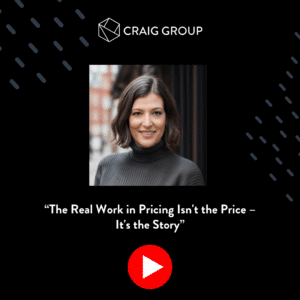5 Strategic Pricing Moves That Beat Doubling Your Marketing Budget

Most CEOs think their customers won’t tolerate a price hike. Meanwhile, competitors are absolutely raising prices behind the scenes, testing market tolerance and capturing margin opportunities.If you’re not actively considering pricing as a growth lever in your revenue growth strategy, you’re missing significant opportunities while your competition gains ground. Here are five strategic moves that deliver immediate results.
1. Stop Training Customers to Expect Discounts
Sales teams naturally gravitate toward discounts and promotions. It’s the path of least resistance when closing deals gets challenging. The problem? These price concessions rarely appear in revenue forecasts, creating an invisible leak in your growth strategy.
When sales reps consistently offer 10%, 15%, or 20% off to close deals, they’re not just reducing immediate revenue. They’re training customers to expect lower prices. This creates a dangerous precedent where your true price becomes negotiable by default.
Here’s the strategic advantage: raising your base price by 20% and allowing for typical discount patterns still nets you a 5% increase. But many customers won’t even push for discounts when they clearly understand the value they’re receiving.
Customer perception drives acceptance. Price increases carry less risk than most executives assume, provided the value proposition is crystal clear. Customers who see genuine value in your offering will honor that value and appreciate the relationship you’ve built with them.
2. Understand the Real Data Behind Pricing Fears
At Craig Group, we see that the fear of customer backlash prevents many leaders from exploring strategic price adjustments. This conservative approach means missing significant growth opportunities while competitors actively test market tolerance for higher prices.
However, when we implement pricing changes with our portfolio companies, the results consistently surprise executives:
- Only approximately 6% of customers push back meaningfully on price increases
- Over 50% accept changes without any objection whatsoever
- The remaining customers often become opportunities for deeper value conversations
- Sales teams experience minimal strain while delivering immediate EBITDA improvements
This strategy translates to measurable growth with proper value positioning. The companies that avoid pricing discussions are often the ones leaving the most money on the table.
3. Build Messaging That Makes Premium Pricing Obvious
Strategic pricing requires more than numerical adjustments. It demands systematic value communication that makes your worth obvious before price enters the conversation.
When we come into pricing engagements, we examine both the quantitative pricing changes and the qualitative value messaging component. Your sales team needs specific tools to defend price points: case studies, ROI calculators, competitive comparisons, and outcome-focused messaging that makes premium pricing feel justified rather than expensive.
Here’s the truth – if price isn’t creating profit, then marketing is just decorating the margins.
Effective pricing strategy connects directly to measurable customer outcomes. When your pricing model aligns with the value you create for customers, price increases become investments in better service, enhanced features, or stronger support, not arbitrary margin grabs.The strongest pricing positions emerge when customers can clearly see the ROI they receive from your offering. This transforms pricing conversations from cost justifications into value demonstrations.
4. Treat Pricing as Your Competitive Weapon
Strategic pricing as a competitive advantage requires treating it as a weapon for margin expansion and market positioning, not a concession tool you use when negotiations get challenging.
While you’re playing defense, concerned about customer reactions, your competitors are playing offense. They’re experimenting with pricing models, testing market tolerance, and discovering what customers will actually pay for demonstrated value.
What to implement:
- Revenue Planning Integration: Account for typical discount patterns in your forecasting to prevent margin erosion
- Sales Team Enablement: Equip reps with value narratives, competitive positioning, and outcome-focused messaging tools
- Customer Communication Strategy: Develop clear value propositions that connect pricing to measurable business outcomes
- Market Testing Approach: Systematically test price tolerance across customer segments before full implementation
- Performance Monitoring: Track both acceptance rates and customer satisfaction to optimize messaging approaches
5. Track the Metrics That Actually Matter
Most companies track vanity metrics instead of the numbers that drive profitability. Strategic pricing success requires monitoring specific indicators that reveal both immediate impact and long-term sustainability.
What You Should Be Tracking:
- Customer acceptance rate of price increases (target: 90%+ acceptance)
- Average discount percentage offered by sales team (should decrease over time)
- Customer acquisition cost relative to pricing changes
- EBITDA impact from pricing adjustments
- Customer retention rates post-price increase
The Bottom Line: Price for Value, Not Tolerance
Strategic pricing isn’t about what customers will tolerate. It’s about what they’ll gladly pay for when they understand the value. The companies winning with strategic pricing understand that sustainable growth comes from customers who want to pay for the value you provide, not customers who begrudgingly accept the lowest price you’re willing to offer.
At Craig Group, we’ve seen this strategic growth advisory approach transform portfolio company value creation through improved margins while strengthening customer relationships. Strategic price increases backed by strong value communication don’t just boost profits. They attract better customers and create sustainable competitive advantages.
Ready to capture the 15-25% margin expansion your competitors are already testing? Schedule a Strategic Pricing Assessment with Craig Group to discover your specific pricing opportunities and get a 90-day value creation plan private equity firms use to deliver immediate EBITDA improvements through our 90-day implementation roadmap.
Managing Partner Summer Craig is a respected commercial leader and LMM growth expert with a background leading change management and GTM strategies for both Fortune 500 and PE-backed high growth companies. Connect with her on LinkedIn.







